Как живые: Двуногие змеи, акулы-зомби и другие исчезнувшие животные - Журавлёв Андрей Юрьевич
Ahlberg P. E. Follow the footprints and mind the gaps: a new look at the origin of tetrapods. Transactions of the Royal Society of Edinburgh: Earth and Environmental Science, 2019, 109, 115–37.
Ahlberg P. E., Beznosov P. A. The significance of the Devonian tetrapods of Timan. Paleontological Journal, 2022, 56, 1029–31.
Ahlberg P. E., Johanson Z. Osteolepiforms and the ancestry of tetrapods. Nature, 1998, 395, 792–4.
Ahlberg P. E., Clack J. A., Lukševičs E. Rapid braincase evolution between Panderichthys and the earliest tetrapods. Nature, 1996, 381, 61–4.
Anderson J. S., Reisz R. R., Scott D., Fröbisch N. B., Sumida S. S. A stem batrachian from the Early Permian of Texas and the origin of frogs and salamanders. Nature, 2008, 453, 515–8.
Barnes B. D., Sclafani J. A., Zaffos A. Dead clades walking are a pervasive macroevolutionary pattern. Proceedings of the National Academy of Sciences of the USA, 2021, 118, e2019208118.
Berquist R. M., Galinsky V. L., Kajiura S. M., Frank L. R. The coelacanth rostral organ is a unique low-resolution electro-detector that facilitates the feeding strike. Scientific Reports, 2015, 5, 8962.
Beznosov P. A., Clack J. A., Lukševičs E., Ruta M., Ahlberg P. E. Morphology of earliest reconstructable tetrapod Parmastega aelidae. Nature, 2019, 574, 527–31.
Boisvert C. A. The pelvic fin and girdle of Panderichthys and the origin of tetrapod locomotion. Nature, 2005, 438, 1145–7.
Boisvert C. A., Joss J. M. P., Ahlberg P. A. Comparative pelvic development of the axolotl (Amblystoma mexicanum) and the Australian lungfish (Neoceratodus forsteri): conservation and innovation across the fish-tetrapod transition. EvoDevo, 2013, 4, 3.
Boisvert C. A., Mark-Kurik E., Ahlberg P. A. The pectoral fin of Panderichthys and the origin of digits. Nature, 2008, 456, 636–8.
Brazeau M. D., Ahlberg P. A. Tetrapod-like middle ear architecture in a Devonian fish. Nature, 2006, 439, 318–21.
Brito P. M., Meunier F. J., Clément G., Geffard-Kuriyama D. The histological structure of the calcified lung of the fossil coelacanth Axelrodichthys araripensis (Actinistia: Mawsoniidae). Palaeontology, 2010, 53, 1281–90.
Byrne H. M., Green J. A. M., Balbus S. A., Ahlberg P. A. Tides: A key environmental driver of osteichthyan evolution and the fish-tetrapod transition? Proceedings of the Royal Society of London A, 2020, 476, 20200355.
Bystrow A. P. Zahnstruktur der Labyrinthodonten. Acta Zoologica, 1938, 19, 387–425.
Carter A. M., Hsieh S. T., Dodson P., Sallan L. Early amphibian evolved distinct vertebrae for habitat invasion. PLoS ONE, 2021, 16 (6), e0251983.
Cavin L., Guinot G. Coelacanths as «almost living fossils». Frontiers in Ecology and Evolution, 2014, 2 (49), doi:10.3389/fevo.2014.00049.
Clack J. A. Devonian climate change, breathing, and the origin of the tetrapod stem group. Integrative and Comparative Biology, 2007, 47, 510–23.
Clack J. A. et al. A uniquely specialized ear in a very early tetrapod. Nature, 2003, 425, 65–9.
Clack J. A., Ahlberg P. E., Blom H., Finney S. M. A new genus of Devonian tetrapod from North-East Greenland, with new information on the lower jaw of Ichthyostega. Palaeontology, 2012, 55, 73–86.
Cloutier R. et al. Elpistostege and the origin of the vertebrate hand. Nature, 2020, 579, 549–54.
Coates M. I. The Devonian tetrapod Acanthostega gunnari Jarvik: postcranial anatomy, basal tetrapod interrelationships and patterns of skeletal evolution. Transactions of the Royal Society of Edinburgh: Earth Sciences, 1996, 87, 363–421.
Coates M. I., Clack J. A. Polydactyly in the earliest known tetrapod limbs. Nature, 1990, 347, 66–9.
Coates M. I., Clack J. A. Fish-like gills and breathing in the earliest known tetrapod. Nature, 1991, 352, 234–6.
Cope E. D. Third contribution to the history of the Vertebrata of the Permian formation of Texas. Proceedings of the American Philosophical Society, 1882, 20, 447–61.
Cosgriff J. W., Zawiskie J. M. A new species of the Rhytidosteidae from the Lystrosaurus Zone and a review of the Rhytidosteoidea. Palaeontologia Africana, 1979, 22, 1–27.
Cruickshank A. R. I., Skews B. W. The functional significance of nectridean tabular horns (Amphibia: Lepospondyli). Proceedings of the Royal Society of London B: Biological Sciences, 1980, 209, 513–37.
Cupello C. et al. (2022) Lung evolution in vertebrates and the water-to-land transition. eLife, 11, e77156.
Daeschler E. B., Shubin N. H., Jenkins F. A. Jr. A Devonian tetrapod-like fish and the evolution of tetrapod body plan. Nature, 2006, 440, 757–63.
Dalquest W. W., Mamay S. H. A remarkable concentration of Permian amphibian remains in Haskell County, Texas. Journal of Geology, 1963, 71, 641–4.
Douthitt H. The structure and relationships of Diplocaulus. Contributions from Walker Museum, 1917, II (1), 1–41.
Dutel H., Herbin M., Clément G., Herrel A. Bite force in the extant coelacanth Latimeria: the role of the intracranial joint and the basicranial muscle. Current Biology, 2015, 25, 1–6.
Dutel H. et al. Neurocranial development of the coelacanth and the evolution of the sarcopterygian head. Nature, 2019, 569, 556–9.
Ferrante C., Cavin L. Early Mesozoic burst of morphological disparity in the slow-evolving coelacanth fish lineage. Scientific Reports, 2023, 13, 11356.
Fortuny J., Marcé-Nogué J., De Esteban-Trivigno S., Gil L., Galobart À. Temnospondyli bite club: ecomorphological patterns in the most diverse group of early tetrapods. Journal of Evolutionary Biology, 2011, 24, 2040–54.
Fortuny J., Marcé-Nogué J., Gil L., Galobart À. Skull mechanics and the evolutionary patterns of the otic notch closure in capitosaurs (Amphibia: Temnospondyli). The Anatomical Record, 2012, 295, 1134–46.
Fortuny J. et al. Comparative 3D analyses and palaeoecology of giant early amphibians (Temnospondyli: Stereospondyli). Scientific Reports, 2016, 6, 30387.
Fricke H., Reinicke O., Hofer H., Nachtigall W. Locomotion of the coelacanth Latimeria chalumnae in its natural environment. Nature, 1987, 329, 331–3.
Friedman M., Coates M. I., Anderson P. First discovery of a primitive coelacanth fin fills a major gap in the evolution of lobed fins and limbs. Evolution & Development, 2007, 9, 329–37.
Fritzsch B., Schultze H.-P., Elliott K. L. The evolution of the various structures required for hearing in Latimeria and tetrapods. IBRO Neuroscience Reports, 2023, 14, 325–41.
Gee B. M., Haridy Y., Reisz R. R. Histological characterization of denticulate palatal plates in an Early Permian dissorophoid. PeerJ, 2017, 5, e3727.
Graham J. B. et al. Spiracular breathing in polypterid fishes and its implications for aerial respiration in stem tetrapods. Nature Communications, 2014, 5, 3022.
Hirasawa T. et al. Morphology of Palaeospondylus shows affinity to tetrapod ancestor. Nature, 2022, 606, 109–12.
Hu Y., Young G. C., Lu J. The Upper Devonian tetrapodomorph Gogonasus andrewsae from Western Australia: Reconstruction of the shoulder girdle and opercular series using X-Ray Micro-Computed Tomography. Palaeoworld, 2019, 28, 535–42.
Holland T. The endocranial anatomy of Gogonasus andrewsae Long, 1985 revealed through CT-scanning. Transactions of the Royal Society of Edinburgh: Earth and Environmental Science, 2014, 105, 9–34.
Jarvik E. The Devonian tetrapod Ichthyostega. Fossils and Strata, 1996, 40, 1–213.




